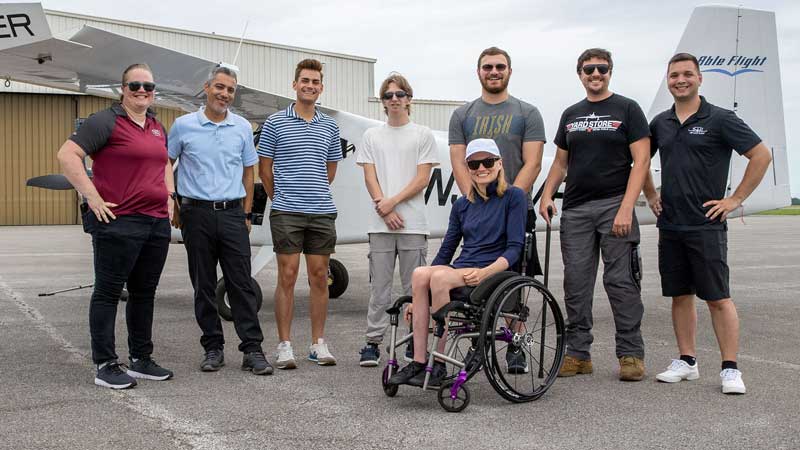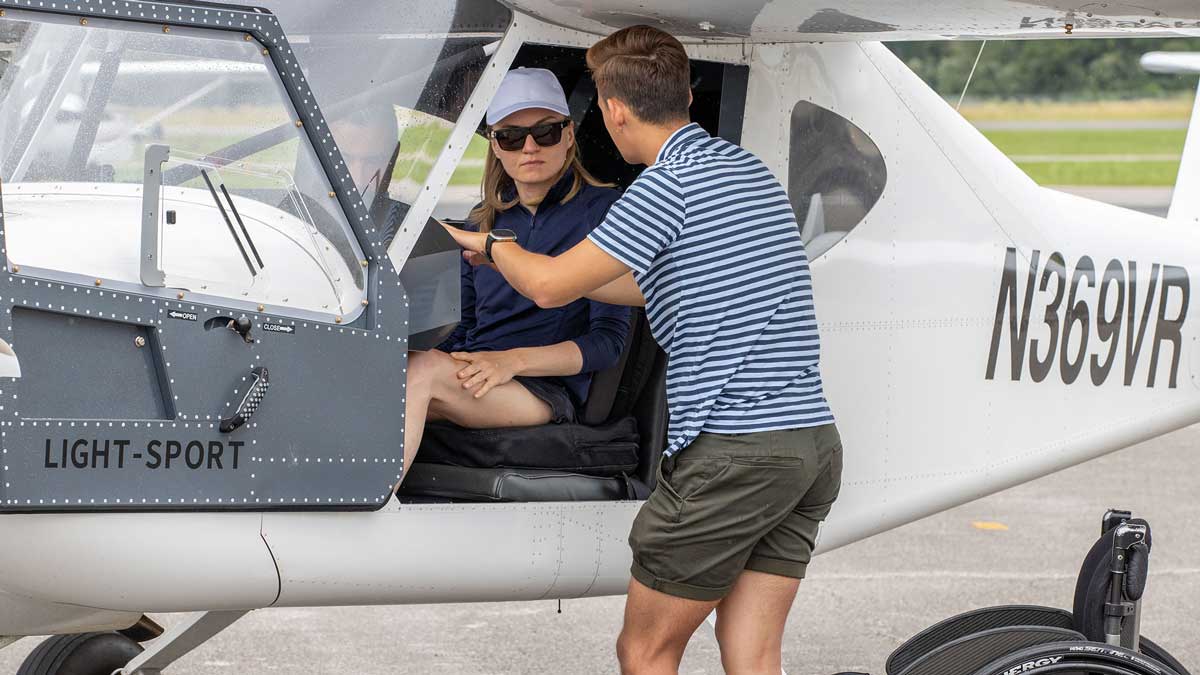
Able Flight student Natallia Mirashnichenka at the controls of the Vashon Ranger Light Sport airplane, with SIU Aviation’s David Nelson, is part of a program to train people with physical disabilities to become licensed pilots. Below: The first SIU Aviation-Able Flight class is, in front, student Natallia Mirashnichenka, and back row, from left, SIU Aviation’s Victoria Mathieu, Miguel Marroquin and David Nelson, students Jordan Sprague, Andrew Daigneau and Ian Azeredo, and SIU Aviation’s Zachary Martine. Not pictured is Able Flight student Jake Simmons. (Photos by Russell Bailey)
June 24, 2024
Able Flight, SIU Aviation help student pilots with disabilities find their wings
CARBONDALE, Ill. — Ian Azeredo smiled while discussing a recent day that he successfully soloed and landed a specially adapted Vashon Ranger Light Sport airplane at Southern Illinois Airport as part of the Able Flight program at Southern Illinois University Carbondale.
Nearly five years earlier on July 4, 2019, Azeredo was involved in a quickly intensifying and ultimately catastrophic skydiving accident — impacting the ground at 70 mph and bouncing 67 feet — and resulting with him spending two months in a coma and nine months in the hospital. In the recovery and rehabilitation that followed, Azeredo’s determination and meeting challenges in “incremental” steps led him to SIU’s School of Aviation and another success.
In recalling his landings in the Vashon Ranger, Azeredo, who is from Ringwood, New Jersey, said, “You are looking at that landing, and it’s that situation of, ‘Here I am again. Here’s that situation that nearly killed me. Can I do this effectively?’ And I did it! It’s been like eight times so far that I’ve been able to come back and safely succeed at a practice that almost put me in my grave years ago.”
Azeredo is one of five students at SIU Carbondale since late May enrolled in Able Flight, a national nonprofit program for people with disabilities to become licensed pilots certified to operate light sport aircraft. The students received scholarships through Able Flight and have been staying in university housing. The training for Azeredo, Natallia Mirashnichenka, Jake Simmons, Andrew Daigneau and Jordan Sprague is expected to conclude this week.
Media availability
Reporters, photographers and camera crews interested in interviewing SIU Aviation training staff and Able Flight students should contact Victoria Mathieu, associate instructor, SIU Aviation, at 618-453-9238 or victoria.mathieu@siu.edu or Charles Stites, Able Flight executive director, at 919-942-4699 or cstites@ableflight.org to make arrangements.
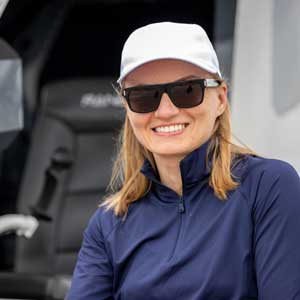 Mirashnichenka, a naturalized U.S. citizen from Belarus now living in New York City, competed in the 50m butterfly both as a Paralympian and for her Baruch College women’s swimming team. Mirashnichenka, who works in finance, learned of Able Flight after being told by a private flight instructor during a lesson that there was most likely no way she would be able to pilot a plane.
Mirashnichenka, a naturalized U.S. citizen from Belarus now living in New York City, competed in the 50m butterfly both as a Paralympian and for her Baruch College women’s swimming team. Mirashnichenka, who works in finance, learned of Able Flight after being told by a private flight instructor during a lesson that there was most likely no way she would be able to pilot a plane.
“Everybody who is involved in the program making it possible for us to safely pilot an airplane is quite impressive,” she said. “After starting the training, I realized the great amount of effort it took to create this opportunity so that we can learn to pilot a plane safely. The fact that this program is happening is a miracle.”
“I’ve always liked heights, so I tried skydiving before,” Mirashnichenka said, adding that piloting a plane was a bit scary “when you are not used to all the unusual attitudes.” She is looking into the possibilities of continuing to fly once the program is over.
“It’s very exciting when you start learning to operate an airplane, and you see that you can actually do it.”
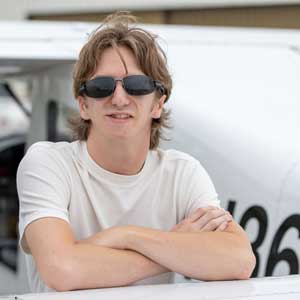 Jordan Sprague, who is from Fort Wayne, Indiana, is a 2023 high school graduate and has a family history of pilots. He started working on a private pilot course and learning the fundamentals of flying when he learned about the program.
Jordan Sprague, who is from Fort Wayne, Indiana, is a 2023 high school graduate and has a family history of pilots. He started working on a private pilot course and learning the fundamentals of flying when he learned about the program.
“This is an amazing program, especially for people with disabilities who may not receive their medical” FAA clearance or not have the opportunity to pursue their dream, he said.
“This is a very exhilarating course. It has allowed me to do things that I never thought I would do,” he said. “There is a feeling when you are up there that is simply unimaginable. I just love it.”
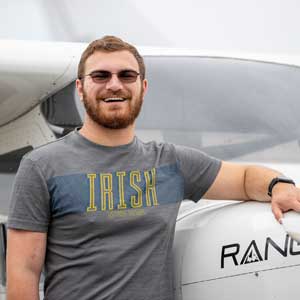 For Andrew Daigneau, who is from South Bend, Indiana, aviation is also in his family, with his father, uncle and a grandfather all pilots. Daigneau graduated in finance from the University of Notre Dame on May 19 and immediately came to the program.
For Andrew Daigneau, who is from South Bend, Indiana, aviation is also in his family, with his father, uncle and a grandfather all pilots. Daigneau graduated in finance from the University of Notre Dame on May 19 and immediately came to the program.
“I had always wanted to fly,” he said. “I always thought that it would be more of a hobby of mine rather than a career since I was interested in business. After my accident, I wasn’t so sure that was going to happen.”
Daigneau said the experience has been a “good perspective shift for me to see some of the people with similar conditions and who are getting after it in life and who are trying to continue to further themselves and chasing their goals.
“It’s also been encouraging for me. Part of what happens after an injury like this is finding the balance between pushing for more and accepting the world now.”
Daigneau added that the pace and progression from learning to fly and being the first student to fly solo and feeling comfortable doing so was in just about three weeks, and he credits the instructors.
“I know this is new for the instructors, too, dealing with adaptive airplanes and adaptive students,” he said. “It’s been wonderful. They have been great. I have really enjoyed going through this process with them.”
“Model students”
SIU instructors Victoria Mathieu and Zachary Martine are two of the teachers who trained in the adaptive planes. Mathieu praised the students for their work, noting several of them had flown solo already. Some had a little bit of aviation experience while it was an introduction for others, she said.
“Everybody is on a good pace to finish up on time,” Mathieu said.
The adaptive controls in the planes are different than in a regularly fitted private plane but largely have the same handling characteristics and top out at about 100 mph, Martine said. The key is to go “low and slow and enjoy flying for the purpose of flying.”
“The students want to be here,” he said. “They have been putting the leg work in, and they are model students.”
Able Flight-SIU relationship
Adding an Able Flight program to SIU is part of the university’s long history of serving students with disabilities.
Able Flight considered several factors when evaluating the possibility of a long-term relationship with SIU Aviation, said Charles Stites, who founded the incorporated nonprofit in 2006. Able Flight provided SIU with two planes in late March that the university can use when it is not instructing Able Flight students.
In addition to the quality of training the students received, how disabled students would be welcomed to campus and the airport training facility also played a role, he said.
“This program is intensive and demanding not just on our pilots but on the staff providing the training,” he said. “And everything we have seen to this point indicates that SIU is not only providing professional level training; it is also providing a welcoming and supportive environment.
“It speaks well of SIU that when flexibility was needed in developing training schedules that aren't typical of a university semester-based program, and when the students needed a different housing option, the aviation training staff and university administration stepped forward and came up with good, workable solutions. That was a positive indication of their investment in bringing people with a physical disability into aviation.”
Azeredo also credited the instructors for keeping them engaged and “trying to be better, not just adequate.”
“It’s about becoming a master of our craft,” he said. “In the six weeks we have been here, they have really turned us into that, and we are becoming effectively craftsmen of flying, not just doing it safely, not just doing it adequately. It’s been about doing this surgically and intentionally.”
That kind of progress “can only happen when a university like SIU opens its doors to people who just want an equal opportunity to prove they belong in aviation,” Stites said.
Community support
The students mentioned the support they have received while at the aviation facilities and in the community. Mirashnichenka met members of the SIU swim team while working out at the Student Recreation Center.
The instructors and the aviation program “really put a lot of dedication into this, beyond what was asked,” Azeredo said. “They invested a lot of their own personal time and energy into this and that speaks to the organization that is behind this. Everyone we have met all along has been really supportive. I came into this not knowing anything about Southern Illinois; I’m straight up pleased with what we’ve seen.”
(Editor’s note: Mirashnichenka is pronounced Meera-shnee-chenka, Daigneau is pronounced Dag-no and Azeredo is pronounced As-Err-Aye-Doe.)
